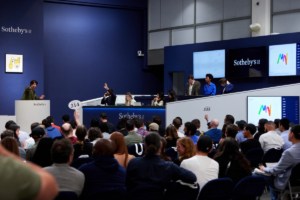Last week was a very eventful one in the art world. Art Basel opened on its home turf in Switzerland, with over 200 galleries presenting works by top international artists (we've highlighted a few selections here). Back in the US, and Web3, in a white-glove auction of digital art from the seized 3AC collection, Sotheby's sold Dmitri Cherniak's iconic Generative Art NFT 'The Goose' for $6.2M. A packed auction room (and even a few IRL bidders) proved an unwavering interest and demand for digital art.
For our 8th Edition of Appraisal Bureau News we are zooming in on fractional art ownership. While technology has granted new formats through which to diversify one's financial portfolio by owning a piece of a blue-chip artwork, the concept and practice existed long before. On the theme of art and finance, we also sat down with Rebecca Fine of Athena Art Finance to discuss the business of art lending, read the interview here.
- Caroline Taylor, Founder, Appraisal Bureau
 Sotheby's, Grails: Property from an Iconic Digital Art Collection Part II, June 15
Sotheby's, Grails: Property from an Iconic Digital Art Collection Part II, June 15